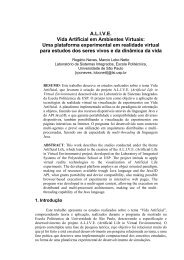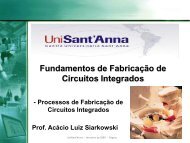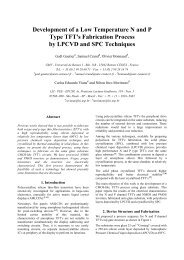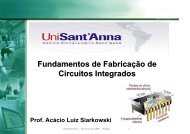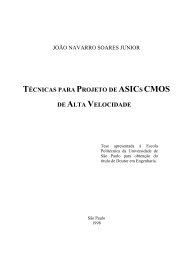grain size influence on sheet resistance of p- and as-implanted ... - LSI
grain size influence on sheet resistance of p- and as-implanted ... - LSI
grain size influence on sheet resistance of p- and as-implanted ... - LSI
Create successful ePaper yourself
Turn your PDF publications into a flip-book with our unique Google optimized e-Paper software.
GRAIN SIZE INFLUENCE ON SHEET RESISTANCE<br />
OF P- AND AS-IMPLANTED POLYCRYSTALLINE<br />
SILICON DEPOSITED BY VERTICAL CVD<br />
REACTOR<br />
TEIXEIRA, R.C.; DOI, I. 1 ; ZAKIA, M. B. P.; SWART, J. W. 1 ; DINIZ, J. A.<br />
Center for Semic<strong>on</strong>ductors Comp<strong>on</strong>ents – State University <strong>of</strong> Campin<strong>as</strong>,<br />
1 Faculty <strong>of</strong> Electrical <strong>and</strong> Computer Engineering – State University <strong>of</strong> Campin<strong>as</strong><br />
Cidade Universitária Zeferino Vaz,<br />
R. P<strong>and</strong>iá Calóger<strong>as</strong>, 90, CEP: 13083-970, Caixa Postal 6061, Campin<strong>as</strong> – SP – Br<strong>as</strong>il<br />
rcotrin@led.unicamp.br; ioshiaki@fee.unicamp.br<br />
Abstract<br />
We have investigated the <str<strong>on</strong>g>influence</str<strong>on</strong>g> <strong>of</strong> <str<strong>on</strong>g>grain</str<strong>on</strong>g> <str<strong>on</strong>g>size</str<strong>on</strong>g> <strong>on</strong> <strong>sheet</strong><br />
<strong>resistance</strong> (R S ) <strong>of</strong> doped polycrystalline Silic<strong>on</strong> films<br />
(poly-Si). Poly-Si samples were prepared in a vertical<br />
type CVD reactor in a wide range <strong>of</strong> depositi<strong>on</strong><br />
c<strong>on</strong>diti<strong>on</strong>s, <strong>and</strong> <strong>implanted</strong> with P at doses <strong>of</strong> 1x10 16 <strong>and</strong><br />
2x10 16 cm -2 , or with As at 1x10 16 cm -2 . The <strong>sheet</strong><br />
<strong>resistance</strong> depends <strong>on</strong> the <strong>implanted</strong> species <strong>and</strong> it is<br />
closely related to the texture, mainly the <str<strong>on</strong>g>grain</str<strong>on</strong>g> <str<strong>on</strong>g>size</str<strong>on</strong>g>, <strong>of</strong><br />
the obtained poly-Si layer. R S depends inversely <strong>on</strong> <str<strong>on</strong>g>grain</str<strong>on</strong>g><br />
<str<strong>on</strong>g>size</str<strong>on</strong>g> <strong>and</strong> P-doped films exhibit lower R S values than Asdoped<br />
films. This behavior can be due to different<br />
segregati<strong>on</strong> <strong>of</strong> the dopant atoms at the <str<strong>on</strong>g>grain</str<strong>on</strong>g> boundaries.<br />
1. Introducti<strong>on</strong><br />
Doped polycrystalline Silic<strong>on</strong> (poly-Si) is largely used in<br />
V<strong>LSI</strong> technology <strong>as</strong> gate electrode in MOS (Metal-<br />
Oxide-Semic<strong>on</strong>ductor) structure <strong>and</strong> interc<strong>on</strong>necti<strong>on</strong>s<br />
[1]. Its electrical properties are closely related to the<br />
crystalline structure <strong>of</strong> the deposited film, <strong>on</strong>ce<br />
amorphous ph<strong>as</strong>e does not become electrically active by<br />
doping/annealing [1]. Grain <str<strong>on</strong>g>size</str<strong>on</strong>g> <strong>and</strong> preferential<br />
orientati<strong>on</strong> (PO), or texture, <strong>of</strong> deposited films can affect<br />
the electrical properties <strong>of</strong> doped samples [2]. The<br />
smaller the <str<strong>on</strong>g>grain</str<strong>on</strong>g> <str<strong>on</strong>g>size</str<strong>on</strong>g> the higher the percentage <strong>of</strong><br />
amorphous ph<strong>as</strong>e at the <str<strong>on</strong>g>grain</str<strong>on</strong>g> boundaries, thus leading to<br />
an incre<strong>as</strong>e in R S [1-3]. Both PO <strong>and</strong> <str<strong>on</strong>g>grain</str<strong>on</strong>g> <str<strong>on</strong>g>size</str<strong>on</strong>g> are<br />
str<strong>on</strong>gly <str<strong>on</strong>g>influence</str<strong>on</strong>g>d by c<strong>on</strong>diti<strong>on</strong>s used in depositi<strong>on</strong><br />
process <strong>of</strong> poly-Si thin films, particularly by temperature<br />
<strong>and</strong> total pressure, <strong>and</strong> annealing techniques employed.<br />
In this work we study the texture <strong>of</strong> the P- <strong>and</strong> As<strong>implanted</strong><br />
poly-Si thin films deposited at different<br />
process c<strong>on</strong>diti<strong>on</strong>s <strong>and</strong> analyzed the dependence <strong>of</strong> the<br />
<strong>sheet</strong> <strong>resistance</strong> (R S ) with the <str<strong>on</strong>g>grain</str<strong>on</strong>g> <str<strong>on</strong>g>size</str<strong>on</strong>g>. The analyses<br />
show that for both P- <strong>and</strong> As-<strong>implanted</strong> poly-Si samples,<br />
<str<strong>on</strong>g>grain</str<strong>on</strong>g> <str<strong>on</strong>g>size</str<strong>on</strong>g> affects inversely <strong>on</strong> <strong>sheet</strong> <strong>resistance</strong>. P-doped<br />
samples exhibit R S values in the order <strong>of</strong> 20 - 50 Ω/sq<br />
adequate for applicati<strong>on</strong>s in electr<strong>on</strong>ic devices, while Asdoped<br />
samples exhibit values 2 or 3 orders <strong>of</strong> magnitude<br />
higher.<br />
2. Experimental<br />
1.5 µm thick poly-Si films were deposited in a Vertical<br />
CVD Epitaxial Reactor at the Center for Semic<strong>on</strong>ductors<br />
Comp<strong>on</strong>ents <strong>of</strong> State University <strong>of</strong> Campin<strong>as</strong> (CCS-<br />
UNICAMP) using Hydrogen diluted SiH 4 . The<br />
experimental arrangement is schematically shown in<br />
figure (1).<br />
Figure 1: Schematic <strong>of</strong> the Experimental Assembly used for<br />
poly-Si depositi<strong>on</strong>.<br />
The reacti<strong>on</strong> chamber is c<strong>on</strong>stituted by a quartz bell jar,<br />
<strong>and</strong> a graphite susceptor, where samples lay for<br />
depositi<strong>on</strong>. A RF (10 kHz, 30 KVA) inducti<strong>on</strong> coil<br />
located just below the graphite susceptor heats the<br />
substrate to the required depositi<strong>on</strong> temperature. The<br />
susceptor is also provided with a rotating mechanism to<br />
ensure a uniform g<strong>as</strong> <strong>and</strong> temperature distributi<strong>on</strong> over<br />
the samples. G<strong>as</strong>es used in the process are introduced<br />
into the reactor in an <strong>as</strong>cending flow from a 3/8 in.<br />
diameter quartz tube located in the middle <strong>of</strong> the<br />
susceptor.
The substrates used for poly-Si depositi<strong>on</strong> were a 2-in.<br />
oriented p-type silic<strong>on</strong> wafer covered with a<br />
0.6 µm thermal oxide layer. The depositi<strong>on</strong> temperature<br />
w<strong>as</strong> m<strong>on</strong>itored by an infrared optical pyrometer <strong>and</strong> rate<br />
flows <strong>of</strong> reagent g<strong>as</strong>es were c<strong>on</strong>trolled by a M<strong>as</strong>s Flow<br />
Meter (QSiH 4 ) <strong>and</strong> rotameter type flow meter (QH 2 ).<br />
The c<strong>on</strong>diti<strong>on</strong>s used for the depositi<strong>on</strong>s are presented in<br />
Table (1):<br />
Pressure 5 – 100 Torr<br />
Temperature 620 – 1,000 °C<br />
QsiH 4 10 – 60 sccm<br />
QH 2 980 – 36,100 sccm<br />
Table 1: C<strong>on</strong>diti<strong>on</strong>s used for depositi<strong>on</strong> <strong>of</strong> poly-Si films<br />
The doping <strong>of</strong> poly-Si samples w<strong>as</strong> achieved by<br />
implanting P at doses <strong>of</strong> 1x10 16 cm -2 <strong>and</strong> 2x10 16 cm -2 or<br />
As at dose <strong>of</strong> 1x10 16 cm -2 , all with 150 keV. The post<br />
implantati<strong>on</strong> annealing w<strong>as</strong> performed after RCA<br />
cleaning in RTA process at 960 °C temperature during<br />
40 sec in N 2 atmosphere, to activate <strong>implanted</strong> species<br />
<strong>and</strong> to recover the crystalline damage (the high<br />
implantati<strong>on</strong> doses used in this work can completely<br />
amorphize the <strong>implanted</strong> regi<strong>on</strong> [4]).<br />
X-Ray Diffracti<strong>on</strong> (XRD) w<strong>as</strong> used to characterize the<br />
dominant crystal orientati<strong>on</strong> (texture) <strong>and</strong> <str<strong>on</strong>g>grain</str<strong>on</strong>g> <str<strong>on</strong>g>size</str<strong>on</strong>g> (D)<br />
<strong>of</strong> the annealed films. Electrical properties (<strong>sheet</strong><br />
<strong>resistance</strong>) were me<strong>as</strong>ured by four-point probe technique<br />
<strong>and</strong> the data correlated with XRD <str<strong>on</strong>g>grain</str<strong>on</strong>g> <str<strong>on</strong>g>size</str<strong>on</strong>g> calculated<br />
by Scherrer formula [5].<br />
3. Results <strong>and</strong> Discussi<strong>on</strong><br />
Figure (2) shows XRD spectra <strong>of</strong> poly-Si samples<br />
deposited in three different process c<strong>on</strong>diti<strong>on</strong>s in the<br />
Vertical Reactor. One can e<strong>as</strong>ily see from figure (1), by<br />
comparing B with A <strong>and</strong> C with A, that changing the<br />
temperature <strong>and</strong>/or pressure will change the structure <strong>of</strong><br />
the deposited film.<br />
The difference in the growth kinetics can be more clearly<br />
observed verifying the dominant growth orientati<strong>on</strong> or<br />
preferential orientati<strong>on</strong> (PO). PO is determined by<br />
normalizing the me<strong>as</strong>ured XRD intensities to a<br />
completely r<strong>and</strong>om sample (powder) [1]. The<br />
normalized intensities <strong>of</strong> the spectra <strong>of</strong> the samples<br />
disposed in Fig (2) are shown in Fig (3).<br />
Normalized Intensity (%)<br />
400<br />
300<br />
200<br />
100<br />
0<br />
<br />
XRD Directi<strong>on</strong>s<br />
R <strong>and</strong> om Le vel<br />
<br />
Figure 3: normalized intensities <strong>of</strong> the XRD spectra showed<br />
in figure (2)<br />
Higher temperature leads to a more prominent intensity<br />
in directi<strong>on</strong> which can be seen comparing B<br />
(850°C) <strong>and</strong> A (800°C) XRD pr<strong>of</strong>iles in fig. (2), while at<br />
low pressures directi<strong>on</strong> is enhanced, which can be<br />
seen comparing C (5 Torr) <strong>and</strong> A (10 Torr) XRD pr<strong>of</strong>iles<br />
in the same figure. One can notice that the <str<strong>on</strong>g>grain</str<strong>on</strong>g><br />
structure is more sensitive to the temperature than to the<br />
pressure variati<strong>on</strong>. A temperature variati<strong>on</strong> <strong>of</strong> less than<br />
10% causes an expressive incre<strong>as</strong>e in the relative<br />
intensity <strong>of</strong> <strong>and</strong> orientati<strong>on</strong>s when<br />
compared to a 100% pressure variati<strong>on</strong>. The same trend<br />
is observed in <str<strong>on</strong>g>grain</str<strong>on</strong>g> <str<strong>on</strong>g>size</str<strong>on</strong>g> (D). Fig. (4) shows temperature<br />
<str<strong>on</strong>g>influence</str<strong>on</strong>g> <strong>on</strong> D for samples deposited at 100 Torr.<br />
A<br />
B<br />
C<br />
<br />
<br />
<br />
2000<br />
A<br />
1600<br />
740 °C<br />
900 °C<br />
1000 °C<br />
XR D Intensity (a.u.)<br />
B<br />
Grain Size (Å)<br />
1200<br />
800<br />
400<br />
C<br />
0<br />
<br />
Gr owth Directi<strong>on</strong><br />
<br />
28,6° 2 Theta<br />
47,4° 56,3°<br />
Figure 2: XRD spectra showing the texture <strong>of</strong> the poly-Si<br />
films deposited at various process c<strong>on</strong>diti<strong>on</strong>s.<br />
A: P=10 Torr, T=850°C, QSiH 4 =40 sccm, QH 2 =4800 sccm;<br />
B: P=10 Torr, T=800°C, QsiH 4 =40 sccm, QH 2 =4800 sccm;<br />
C: P=5 Torr, T=850°C, QSiH 4 =40 sccm, QH 2 =4800sccm.<br />
Figure 4: Variati<strong>on</strong> <strong>of</strong> the <str<strong>on</strong>g>grain</str<strong>on</strong>g> <str<strong>on</strong>g>size</str<strong>on</strong>g> (D) calculated by<br />
Scherrer Formula [5] <strong>as</strong> a functi<strong>on</strong> <strong>of</strong> temperature <strong>of</strong> the<br />
films deposited at P = 100 Torr, QSiH 4 = 40 sccm,<br />
QH 2 = 36100 sccm<br />
Although other parameters (P, QSiH 4 , <strong>and</strong> QH 2 ) also<br />
<str<strong>on</strong>g>influence</str<strong>on</strong>g> D values [1], the <str<strong>on</strong>g>grain</str<strong>on</strong>g> <str<strong>on</strong>g>size</str<strong>on</strong>g> is more sensitive to
the temperature variati<strong>on</strong>. D variance with temperature is<br />
directly proporti<strong>on</strong>al. In fig (4) <strong>on</strong>e can see that a 35%<br />
variati<strong>on</strong> in temperature incre<strong>as</strong>es <str<strong>on</strong>g>grain</str<strong>on</strong>g> <str<strong>on</strong>g>size</str<strong>on</strong>g> up to 1<br />
order <strong>of</strong> magnitude in the <strong>and</strong> directi<strong>on</strong>s.<br />
oriented <str<strong>on</strong>g>grain</str<strong>on</strong>g>s are also bigger at higher<br />
temperatures. The film thickness also affects the <str<strong>on</strong>g>grain</str<strong>on</strong>g><br />
<str<strong>on</strong>g>size</str<strong>on</strong>g>, but since all samples have the same thickness<br />
(1.5 µm), its <str<strong>on</strong>g>influence</str<strong>on</strong>g> w<strong>as</strong>n’t taken into account in the<br />
analysis.<br />
The variati<strong>on</strong> in the intensities <strong>of</strong> the , <strong>and</strong><br />
peaks <strong>and</strong> in the <str<strong>on</strong>g>grain</str<strong>on</strong>g> <str<strong>on</strong>g>size</str<strong>on</strong>g>s observed in fig. (2) –<br />
(4) indicates that different depositi<strong>on</strong> c<strong>on</strong>diti<strong>on</strong>s affects<br />
the surface diffusi<strong>on</strong> <strong>of</strong> adsorbed species <strong>and</strong> growth<br />
kinetics. So that <strong>on</strong>e or another crystalline growth<br />
directi<strong>on</strong> is benefited for the set <strong>of</strong> employed c<strong>on</strong>diti<strong>on</strong>s.<br />
The higher the temperature, the larger the surface<br />
diffusi<strong>on</strong> length (L) will be thus, adsorbed atoms can<br />
diffuse to a l<strong>on</strong>ger distance until they find a crystalline<br />
nucleus to aggregate to [1]. This process leads to a lower<br />
nucleus density in the initial growth stage, which implies<br />
in larger <str<strong>on</strong>g>grain</str<strong>on</strong>g>s <strong>as</strong> depositi<strong>on</strong> proceeds.<br />
The mixture <strong>of</strong> amorphous <strong>and</strong> crystalline ph<strong>as</strong>es in<br />
poly-Si films leads to R S values significantly higher in<br />
comparis<strong>on</strong> to the single crystalline films. Tables (2) <strong>and</strong><br />
(3) present the Sheet Resistance values (R S ) me<strong>as</strong>ured <strong>on</strong><br />
P- <strong>and</strong> As-<strong>implanted</strong> poly-Si by four-point probe<br />
technique, respectively. Used implantati<strong>on</strong> energy w<strong>as</strong><br />
150 keV in all samples.<br />
Dose<br />
(cm -2 )<br />
Press<br />
(Torr)<br />
Temp<br />
(°C)<br />
QsiH 4<br />
(sccm)<br />
QH 2<br />
(sccm)<br />
D ave<br />
(Å)<br />
R S<br />
(Ω/sq)<br />
2x10 16 10 850 40 4800 676 23,74<br />
90 740 50 25300 657 23,56<br />
100 740 40 36000 372 138,62<br />
1x10 16 100 900 40 36000 736 40,54<br />
100 1000 40 36000 1497 14,36<br />
[6] POCl 3 diff. doped (900°C; 25 min)<br />
1500<br />
– 300 100-500<br />
[7] POCl 3 diff. 950°C; up to 60 min 3500 42 - 190<br />
doped 630 °C; up to 180 sec - 1000 75 - 190<br />
Table 2: Sheet <strong>resistance</strong> R S <strong>of</strong> P-doped poly-Si samples<br />
Dose<br />
(cm -2 )<br />
Press<br />
(Torr)<br />
Temp<br />
(°C)<br />
QsiH 4<br />
(sccm)<br />
QH 2<br />
(sccm)<br />
D ave<br />
(Å)<br />
R S<br />
(Ω/sq)<br />
5 850 40 4800 493 401,36<br />
1x10 16 10 850 40 4800 418 781,43<br />
5 800 40 4800 239 1594,56<br />
1x10 16 [8]<br />
I.I. 70 keV<br />
Oxide cover 1500 20 – 350<br />
- 100<br />
Oxide cover 10-10k<br />
1x10 16 [9]<br />
I.I. 90 keV No cover 100-10M<br />
Table 3: Sheet Resistance R S <strong>of</strong> As-doped poly-Si samples<br />
P-<strong>implanted</strong> samples have R S values in the range <strong>of</strong><br />
14 – 138 Ω/sq for both 1x10 16 <strong>and</strong> 2x10 16 cm -2<br />
implantati<strong>on</strong> doses <strong>and</strong> most samples have R S less than<br />
50 Ω/sq, adequate for microelectr<strong>on</strong>ic applicati<strong>on</strong>s.<br />
As-<strong>implanted</strong> samples have R S values c<strong>on</strong>siderably<br />
higher, in the range <strong>of</strong> 400 – 1600 Ω/sq for implantati<strong>on</strong><br />
doses <strong>of</strong> 1x10 16 cm -2 . In spite <strong>of</strong> the absolute values, <strong>on</strong>e<br />
can see that R S varies inversely <strong>on</strong> average <str<strong>on</strong>g>grain</str<strong>on</strong>g> <str<strong>on</strong>g>size</str<strong>on</strong>g> for<br />
both P- <strong>and</strong> As-<strong>implanted</strong> samples, independent <strong>of</strong> the<br />
depositi<strong>on</strong> c<strong>on</strong>diti<strong>on</strong>s. Samples deposited at quite<br />
different c<strong>on</strong>diti<strong>on</strong>s can produce P-doped films with the<br />
same <str<strong>on</strong>g>grain</str<strong>on</strong>g> <str<strong>on</strong>g>size</str<strong>on</strong>g>, thus with the same R S . Keeping c<strong>on</strong>stant<br />
all other parameters <strong>and</strong> incre<strong>as</strong>ing temperature,<br />
incre<strong>as</strong>es D values <strong>and</strong> this implies in a decre<strong>as</strong>e in R S<br />
values for both P- <strong>and</strong> As-<strong>implanted</strong> samples.<br />
B<strong>and</strong> model proposed by Seto [2] can be used to explain<br />
the obtained results. According to this model, a large<br />
number <strong>of</strong> defects due to incomplete atomic b<strong>on</strong>ding<br />
exists in the <str<strong>on</strong>g>grain</str<strong>on</strong>g> boundaries, which forms trapping<br />
states. This reduces the number <strong>of</strong> free carriers available<br />
for electrical c<strong>on</strong>ducti<strong>on</strong>. After trapping the mobile<br />
carriers, the traps become electrically charged <strong>and</strong> they<br />
create a potential barrier, which impedes the moti<strong>on</strong> <strong>of</strong><br />
carriers from <strong>on</strong>e <str<strong>on</strong>g>grain</str<strong>on</strong>g> to another. The amorphous ph<strong>as</strong>e<br />
is also an insulating regi<strong>on</strong>, which implies in another<br />
potential barrier. The bigger the <str<strong>on</strong>g>grain</str<strong>on</strong>g> <str<strong>on</strong>g>size</str<strong>on</strong>g>, the smaller<br />
the amorphous porti<strong>on</strong> will be, so that, less trapping<br />
states will exist in poly-Si films with big crystalline<br />
<str<strong>on</strong>g>grain</str<strong>on</strong>g>s. This leads to a higher free carrier c<strong>on</strong>centrati<strong>on</strong>,<br />
that reduces the resistivity <strong>of</strong> the poly-Si film, <strong>as</strong><br />
observed.<br />
Differences in R S values for P- <strong>and</strong> As-<strong>implanted</strong><br />
samples can be due to different diffusi<strong>on</strong> mechanisms for<br />
these impurities. P-diffusi<strong>on</strong> is approximately isotropic<br />
in poly-Si so that there is no net flux from or to <str<strong>on</strong>g>grain</str<strong>on</strong>g><br />
boundaries. As-diffusi<strong>on</strong> h<strong>as</strong> a more expressive diffusi<strong>on</strong><br />
coefficient in the amorphous ph<strong>as</strong>e than in the crystalline<br />
ph<strong>as</strong>e. Thus, there is a net flux <strong>of</strong> As-atoms from crystal<br />
<str<strong>on</strong>g>grain</str<strong>on</strong>g> to <str<strong>on</strong>g>grain</str<strong>on</strong>g> boundaries. Since impurities are not<br />
electrically active in the <str<strong>on</strong>g>grain</str<strong>on</strong>g> boundaries [1-3], this<br />
causes the R s values in the As-doped samples to be<br />
higher than in P-doped samples. The vertical<br />
arrangement <strong>of</strong> the <str<strong>on</strong>g>grain</str<strong>on</strong>g> boundaries (crystal <str<strong>on</strong>g>grain</str<strong>on</strong>g>s have<br />
a columnar structure in poly-Si layers) leads As to<br />
diffuse deeper in the poly-Si layer. Besides, As also<br />
diffuses to the atmosphere during annealing<br />
(outdiffusi<strong>on</strong>) if no protecti<strong>on</strong> is used over the <strong>implanted</strong><br />
layer [1, 9-10]. This is the c<strong>as</strong>e <strong>of</strong> our samples. Even<br />
though, R S values for our As-doped samples are<br />
c<strong>on</strong>sistent with the results found in the literature [9-10].<br />
4. C<strong>on</strong>clusi<strong>on</strong><br />
In this study we have observed that temperature is <strong>of</strong><br />
great importance <strong>on</strong> the <str<strong>on</strong>g>grain</str<strong>on</strong>g> <str<strong>on</strong>g>size</str<strong>on</strong>g> <strong>of</strong> deposited poly-Si<br />
layers <strong>and</strong> that <strong>sheet</strong> <strong>resistance</strong> depends inversely <strong>on</strong><br />
<str<strong>on</strong>g>grain</str<strong>on</strong>g> <str<strong>on</strong>g>size</str<strong>on</strong>g>, independent <strong>of</strong> using P or As <strong>as</strong> dopant<br />
impurity. P-<strong>implanted</strong> samples achieved R S values<br />
adequate for applicati<strong>on</strong>s in microelectr<strong>on</strong>ic devices,<br />
while differences <strong>on</strong> the diffusi<strong>on</strong> process lead As<strong>implanted</strong><br />
samples to R S values 2 or 3 orders <strong>of</strong><br />
magnitude higher.
5. Acknowledgments<br />
This work w<strong>as</strong> partially supported by UNICAMP,<br />
FAPESP, CAPES <strong>and</strong> CNPq.<br />
The authors would like to thank José Godoy F° <strong>and</strong> José<br />
Eudóxio C. de Queiroz <strong>of</strong> the CCS-UNICAMP for his<br />
experimental <strong>as</strong>sistance <strong>and</strong> Pr<strong>of</strong>. Dr. Lis<strong>and</strong>ro P.<br />
Cardoso <strong>of</strong> the IFGW-UNICAMP for X-Ray diffracti<strong>on</strong><br />
me<strong>as</strong>urements.<br />
References<br />
[1] Kamins, T. I.; “Polycrystalline Silic<strong>on</strong> for Integrated<br />
Circuit <strong>and</strong> Displays”; Kluwer Academic Publishers, 2ª<br />
editi<strong>on</strong>, 1998.<br />
[2] Seto, J. Y. W.; “The Electrical Properties <strong>of</strong><br />
Polycrystalline Silic<strong>on</strong> Films”; J. Appl. Phys.; pp 5247-<br />
5254, vol 46, n° 12, 1975.<br />
[3] Joshi, D. P.; Sriv<strong>as</strong>tava, R. S.; “A Model <strong>of</strong> Electrical<br />
C<strong>on</strong>ducti<strong>on</strong> in Polycrystalline Silic<strong>on</strong>”; IEEE Trans.<br />
Elect. Dev.; pp. 920-927, Vol ED-31 No 7, 1984.<br />
[4] Ivers<strong>on</strong>, I. B.; Reif, F.; “Recrystalizati<strong>on</strong> <strong>of</strong> Amorphized<br />
Polycrystalline Silic<strong>on</strong> Films <strong>on</strong> SiO 2 ; Temperature<br />
Dependence <strong>of</strong> the Crystallizati<strong>on</strong> Parameters”; J. Appl.<br />
Phys.; pp 1675-1681, Vol 62, n° 5, 1987.<br />
[5] Joubert, P.; Loisel, B.; Chouan, Y.; Haji, L.; “The Effect<br />
<strong>of</strong> Low Pressure <strong>on</strong> the Structure <strong>of</strong> LPCVD<br />
Polycrystalline Silic<strong>on</strong> Films”; J. Electrochem. Soc., pp<br />
2541-2545, vol. 134, n° 10, 1987.<br />
[6] Ibok, E.; Garg, S.; “A Characterizati<strong>on</strong> <strong>of</strong> the Effect <strong>of</strong><br />
Depositi<strong>on</strong> Temperature <strong>on</strong> Polysilic<strong>on</strong> Properties –<br />
Morphology, Dopability, Etchability <strong>and</strong> Polycide<br />
Properties”; J. Electrochem. Soc., pp. 2927-2937, Vol.<br />
140 n° 10, 1993.<br />
[7] Ahmed, W.; Afzal, A.; “Rapid Thermal Annealing <strong>of</strong> In-<br />
Situ p-doped Polycrystalline Silic<strong>on</strong> Thin Films”; J. Mat.<br />
Sci. pp 4955-4958, Vol 34, n° 20, 1999.<br />
[8] Marsh, C.D.; Moiseiwitsch, N. E.; Booker, G. R.;<br />
Ashburn, P.; “Behavior <strong>and</strong> Effects <strong>of</strong> Fluorine in<br />
Annealed n+ Polycristalline Silic<strong>on</strong> Layers <strong>on</strong> Silic<strong>on</strong><br />
Wafers”; J. Appl. Phys. pp 7567-7578, Vol 87, n° 10,<br />
2000.<br />
[9] Chow, R.; Powell, R. A.; “Activati<strong>on</strong> <strong>and</strong> Redistributi<strong>on</strong><br />
<strong>of</strong> Implanted P <strong>and</strong> B in Polycrystalline Si by Rapid<br />
Thermal Processing” J. Vac. Sci. Technol. A pp 892-895,<br />
Vol. 3, n° 3, 1985.<br />
[10] Powell, R. A.; Chow, R.; “Dopant Activati<strong>on</strong> <strong>and</strong><br />
Redistributi<strong>on</strong> in As + -Implanted Polycrystalline Si by<br />
Rapid Thermal Processing” J. Electrochem. Soc., pp.<br />
194-198, Vol 132, n° 1, 1985.




